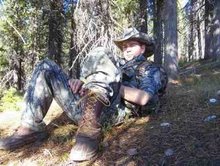WYOMING PRONGHORN HEAD SOUTH TO HELP MEXICAN PRONGHORN POPULATIONS
WYOMING PRONGHORN HEAD SOUTH TO HELP MEXICAN PRONGHORN POPULATIONS
6/22/2007


CHEYENNE – American pronghorn fawns captured near Cheyenne in June are headed to Zacatecas, Mexico as part of a recovery effort to bolster populations of Sonoran and peninsular pronghorn in Mexico.
Biologists and volunteers from the Wyoming Game and Fish Department, F.E. Warren Air Force Base and Mexico spent two weeks capturing 159 pronghorn fawns on F.E. Warren and surrounding property. The first group of fawns were flown to Mexico on June 16, with the remaining fawns scheduled to leave sometime the weekend of June 23.
“Wyoming is lucky to have a wealth of pronghorn,” says Jon Stephens, the Game and Fish Warden who organized the capture effort. “The pronghorns indigenous to Mexico haven’t fared so well, and Mexican biologists were looking for a way to help stabilize their pronghorn populations.”
Some scientists believe there to be five subspecies of pronghorn, including the Sonoran and penisular pronghorn. The capture effort in Wyoming was part of a recovery project formulated in an international pronghorn working group.
“We have the resources in Wyoming to help make this project a success,” says Stephens. “Relocating fawns from the Cheyenne area allows wildlife managers to help control populations using non-lethal techniques. F.E. Warren Air Force Base and other lands in the area do not provide opportunity for hunter harvest because of safety concerns for both people and wildlife. Because of this, the Game and Fish must look at alternative methods to manage and sustain the pronghorn population in southeast Wyoming.”
After the fawns arrive in Mexico, they are released in a natural environment on wildlife preserves or other protected areas where they mature and breed. Scientists are studying how closely the DNA of the Sonoran and peninsular pronghorn resembles that of American pronghorn. If the genetics are determined suitable, some of the of fourth or fifth generation American fawns will be released in the wild with the Sonoran and penisular pronghorn to provide a stable captive breeding population.
Female American fawns may also serve as surrogate mothers. Pronghorn can have up to six embryos, with only three having the potential to develop into fawns. Mexican biologists are studying the viability of taking the unused embryos from the Mexican does and implanting them in the American pronghorn. The hope is to provide twice as many genetically unique Sonoran or penisular fawns each year to help these populations grow more quickly.
“This project brought together people from two countries with different languages for a common goal: wildlife conservation,” says Stephens. “We are happy to help by providing Wyoming fawns, just as Wyoming has received turkeys, bighorn sheep and fish eggs from other agencies in the past.”
Fawns were housed in an outbuilding on F.E. Warren Air Force Base, and were fed by volunteers every 4 hours as they awaited transport. Veterinary care for the fawns was provided by Dr. Mike Driscoll and the staff of Broadmoor East Veterinary Clinic of Cheyenne.
“The fawns went through a rigorous health inspection to pass U.S. and Mexican customs,” explained Stephens. Driscoll inspected each fawn, insuring it was physically able to make the trip to Mexico before submitting his paperwork to the requisite federal agencies so the fawns could travel.
This is the fourth year the Game and Fish has partnered on the project, which is funded by the Mexican counterpart of the U.S. Fish and Wildlife Service. In all, more than 300 fawns from Wyoming have been translocated to Mexico in the last four years.
